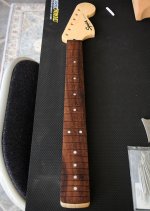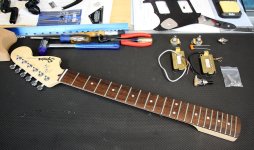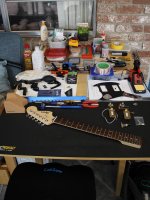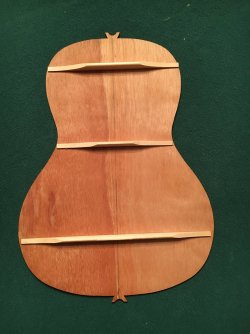I've been waiting on parts to come in before starting on this particular guitar. It is one of the entry level Squier pieces that was dropped onto the bottom strap button, pushing it in a 1/8th inch. I had already drilled out and installed 1/2 inch oak plugs to remount both strap buttons and changed out the saddles to vintage telecaster style but with intonation. However, the list of issues/upgrades wanted on this one was a bit longer.
The fingerboard was supposed to have a 9.5 inch radius but is closer to halfway between 7.25 and 9.5, and the fretwork left a lot to be desired. It has loads of fret buzz all over. I also wanted to change out the plastic nut with a bone and the standard tuners with split shaft tuners off a Affinity level Squier. I will be pulling all the original electronics out and replacing them upgrades such as CTS, Puretone, Wilkinson, etc.
Spent yesterday evening pulling the stock nut and the frets off the board. Then I sanded it down to a proper 9.5 inch radius going through 60, 150, 220, and 400 grits. I gave it a light coat of lemon oil to make cleanup of the superglue easier when I install the new frets. I know they went to laurel wood on the fretboards as it is cheaper, and it definitely is not rosewood. But, it is not bad looking at all.
As I get more done on it I will post a new thread now and then.
The fingerboard was supposed to have a 9.5 inch radius but is closer to halfway between 7.25 and 9.5, and the fretwork left a lot to be desired. It has loads of fret buzz all over. I also wanted to change out the plastic nut with a bone and the standard tuners with split shaft tuners off a Affinity level Squier. I will be pulling all the original electronics out and replacing them upgrades such as CTS, Puretone, Wilkinson, etc.
Spent yesterday evening pulling the stock nut and the frets off the board. Then I sanded it down to a proper 9.5 inch radius going through 60, 150, 220, and 400 grits. I gave it a light coat of lemon oil to make cleanup of the superglue easier when I install the new frets. I know they went to laurel wood on the fretboards as it is cheaper, and it definitely is not rosewood. But, it is not bad looking at all.
As I get more done on it I will post a new thread now and then.
Attachments
Last edited:












